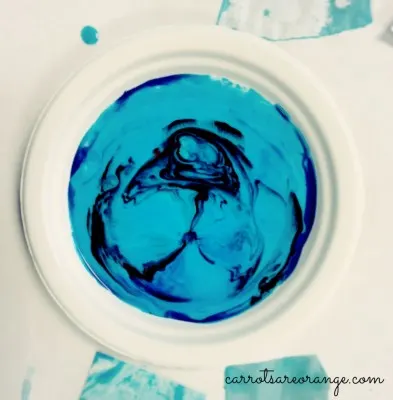I earn commissions from my affiliated links. Please see my disclosure policy for more details.
The Magic Milk experiment is a ton of fun! This science activity with milk & food coloring is great for kindergarten and elementary-aged kids. One of my absolute favorite parts of my Montessori training was science experiments.
Finding creative ways to hook a child, intrigue him, and ignite his desire to want to learn more about a particular subject drove me. The Dancing Milk science experiment is one of my favorite experiments to achieve this hook.

Not only is making milk dance fun for kids and adults to watch but this easy and inexpensive activity also combines science and art and can be done at home or in the classroom. After an explosion of movement, watch this beautiful, graceful dancing milk! Have fun!
Science Activity with Milk & Food Coloring – Magic Milk

Dancing Milk Materials
- Tray
- Dish Soap
- Sponge (for wiping up any mess(
- Plate
- Food Coloring (we used blue, but you can use any color)
- Milk
- Object to Dip into Dish Soap (e.g., key, q-tip)
 A Science Activity with Milk & Food Coloring – How to Make Milk Dance
A Science Activity with Milk & Food Coloring – How to Make Milk Dance
- Gather your dancing milk materials
- Pour milk onto a plate, enough to cover it
- Drop food coloring in various spots in the milk
- Dap your small object into the dish soap
- Gently place a small object with dish soap into milk and food coloring
- Observe what happens to the milk
- Watch the milk dance
Questions to Ask Kids about Magic Milk
- What happens to the milk when the soap meets it?
- What happens when we add another color?
- What would happen if we changed the liquid to be different milk, such as fat-free, buttermilk, or half and half?
- Why does the milk dance differently with these different substances?

Science Behind Magic Milk
Why does milk react to soap & food coloring? Here is a brief explanation of the science behind dancing milk.
Milk has fats and proteins within its makeup that are sensitive to changes in the substance. In our case, this change came from a drop of dish soap. Dish soap has a bipolar quality to it.
This means that dish soap is non-polar on one end and polar on the other. When the soap hits the milk, the soap's bipolar quality weakens the chemical bonds holding the fats and proteins together. The non-polar end of the soap is the center of the party.
The non-polar end “fears” water and attaches to the milk's fat molecules. The fat molecules move in fun ways as the soap molecules attempt to attach themselves to the fat molecules. Food coloring helps us observe a phenomenon that typically is not visible to us.
See Steve Spangler Science for more science experiments like the Dancing Milk experiment.
To take this dancing milk experiment one step further, check out Babble Dabble Do's Marbled Milk Art Activity.
Marnie
